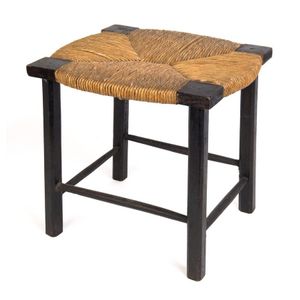William Morris-inspired Rush Seat Stool
You must be a subscriber, and be logged in to view price and dealer details.
Subscribe Now to view actual auction price for this item
When you subscribe, you have the option of setting the currency in which to display prices to $Au, $US, $NZ or Stg.
- Morris, William - William Morris (1834 - 1896) an architect designer, artist, writer, poet and social activist is regarded as a leader of the Arts & Crafts movement in England.
After studying theology, ecclesiastical history, medieval poetry and art at Oxford University, Morris began work with a firm of architects for a short period.
In 1861 he formed a company Morris Marshall, Faulkner & Co. was formed to design and produce wallpaper, carpets, tapestries and stained glass, and they initially secured ecclesiastical works, later extending to domestic assignments.
In 1874 he took sole control of the company, buying out the other partners, and renaming it Morris & Co.
The origins of his designs can be traced to medieval Gothic styles but his organic flower and bird motifs encouraged later artists to seek inspiration for their designs in nature. - Rush Seating - Associated with country style chairs, stools and settees, rush seats are woven from rushes, with the pattern of the weaving often dividing the the chair seat diagonally into four triangles.
The weaving of rushes has been practiced for centuries, and it is believed that some early rush seats of the 18th and 19th century were painted, although common practice now is to leave the rush in its natural state. As the rush ages the colour
Rushes of the type used in Europe for seating are not available in Australia, and instead fibre rush, a man-made product from one-ply twisted paper, is used. Another substitute material is twisted natural sea grass.
Seats in Danish furniture of the 1950s were often finished with Danish cord, a three ply twisted paper cord, which has a similar appearance to rush.
This item has been included into following indexes:
Visually similar items

A refectory table, Cleated plank top standing on large square section legs, lippincott style. Contemporary waxed pine. Length 2,60 cm, width 100 cm

An Australian blackwood serving table, circa 1820, the rectangular panelled top with thumb moulded edge above a single fiddle cut drawer, raised on square tapering legs joined by an H-stretcher, 121 cm wide, 68 cm deep, 71 cm high. Provenance: Old Colony I

A contemporary coromandel console, by Jacques Dubois, the irregular rectangular top above simple square supports united by a cross stretcher, 71 cm high, 76.5 cm wide, 44 cm deep. Provenance: Galerie Jacques de Vos, Paris. Private Collection, Sydney, acqui

Doreen Blumhardt, tile top side table in oxide finish, tiles with green ash grey highlights and blackened cast iron frame, paper label, 41 cm square
